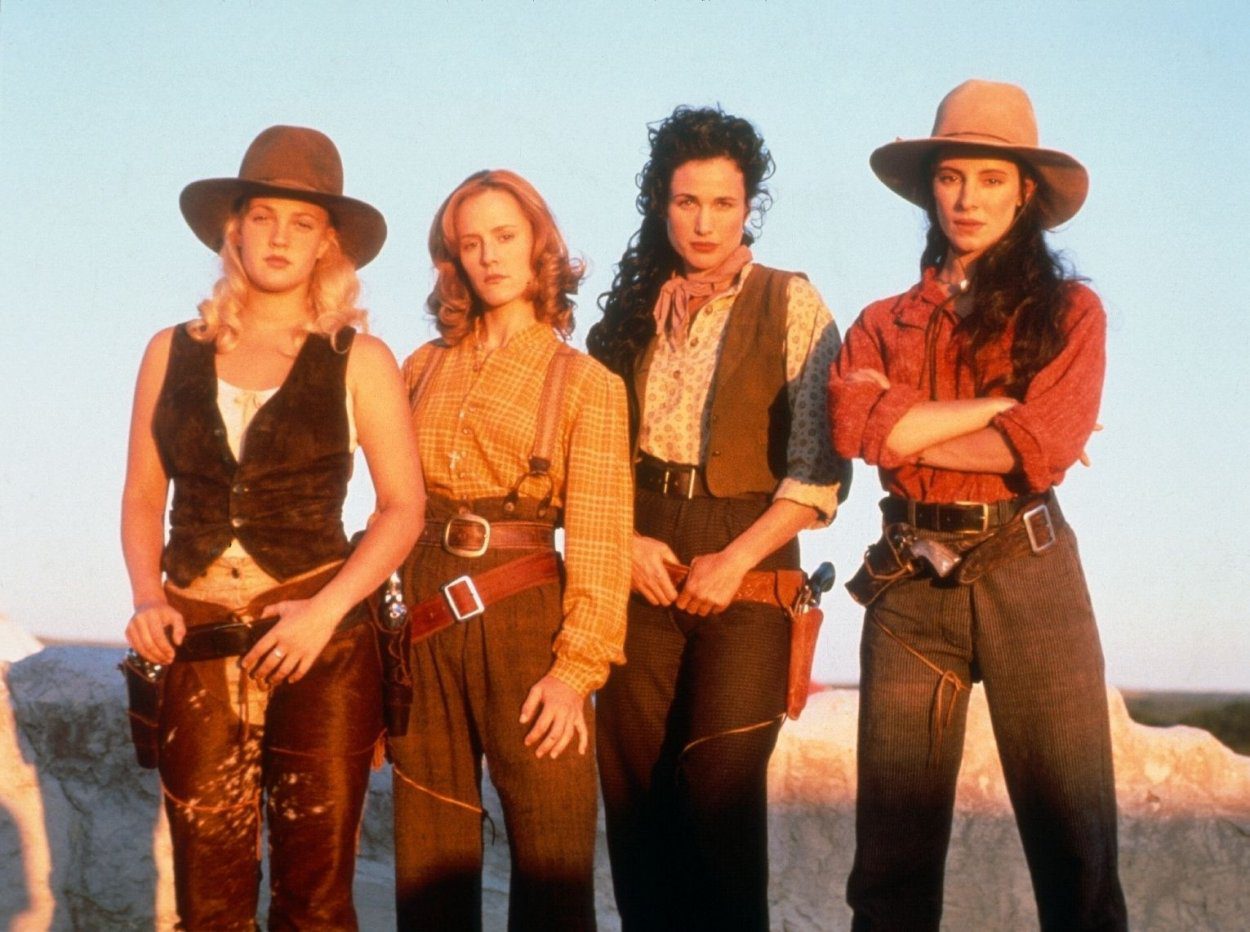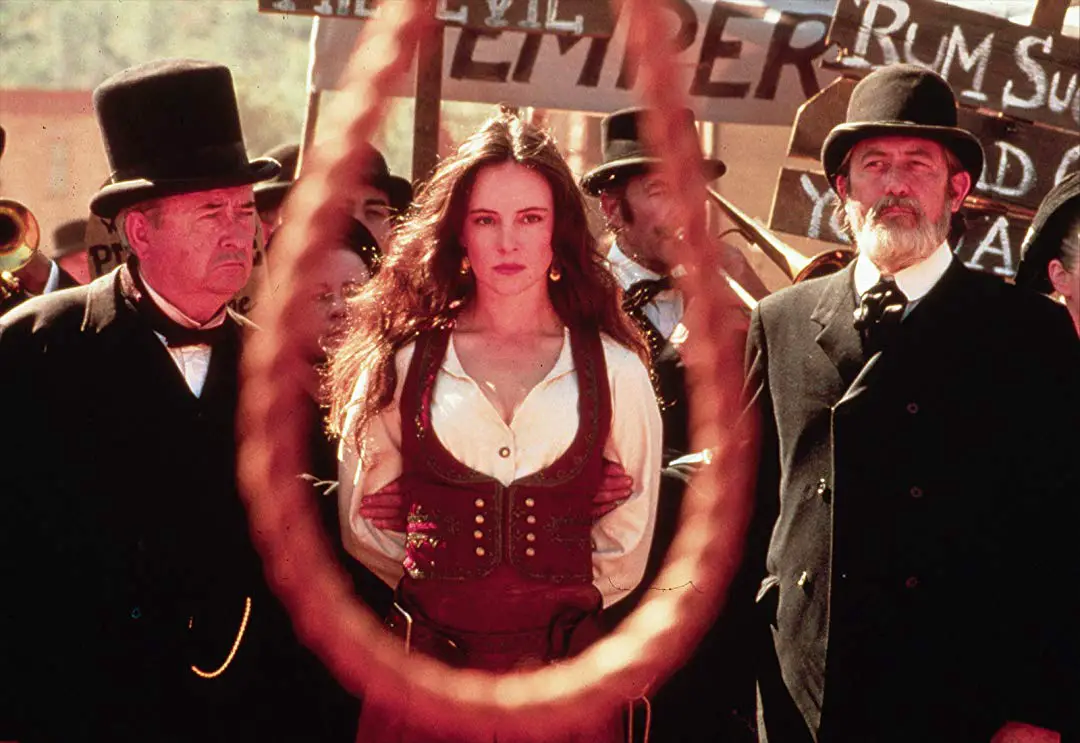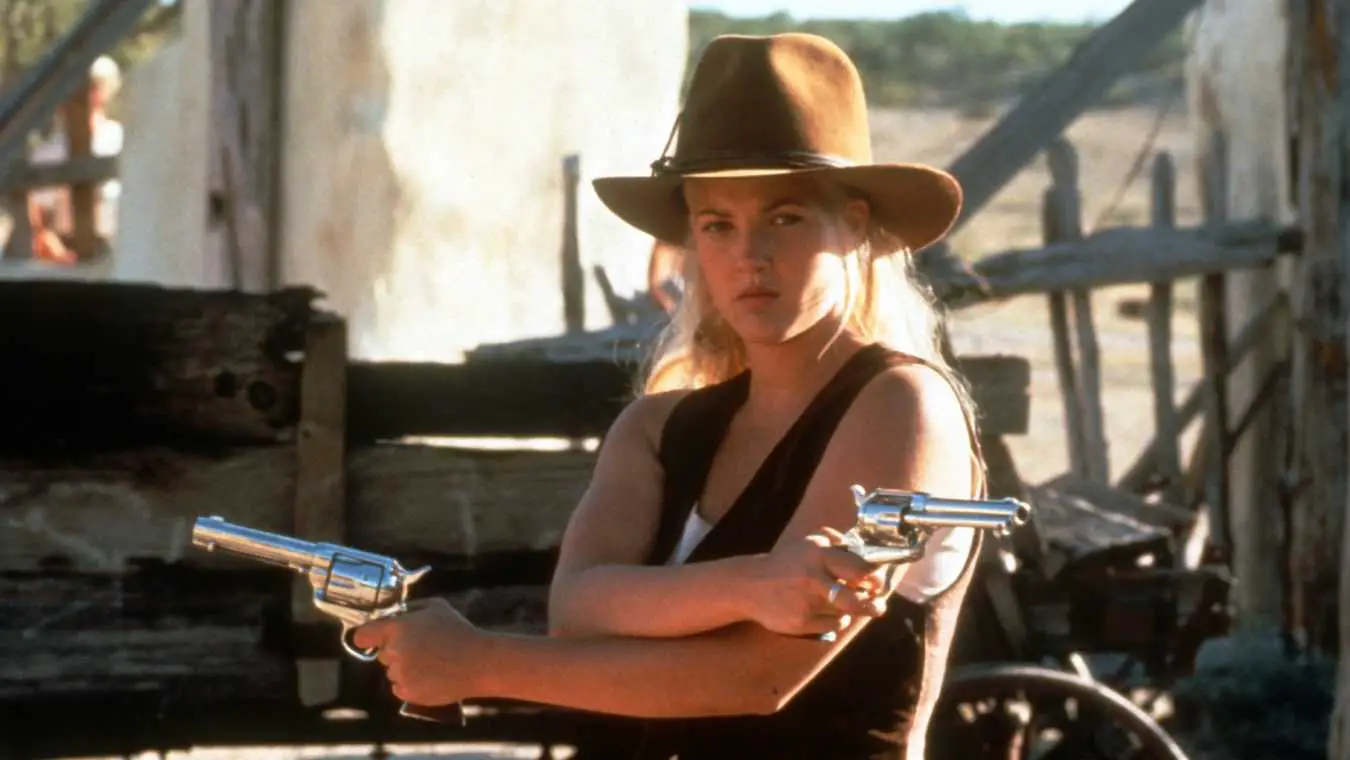When I saw that 1994’s Bad Girls was turning 25 this year, I knew that I wanted to write about it. The first reaction I got was, “Are you sure?” Oh yeah, I’m sure! I know this film isn’t very good. I know from everything I read it was a giant hot mess to make. I know it bombed at the box office. I even know that every time I tell people that I like it, I then spend the next five minutes trying to tell them why. That said, Bad Girls holds a special spot in my heart.
I’m not talking about the Oxygen television series that Google tries to make me think I mean to type (when I obviously don’t). I’m talking about the Western involving four women from Texas trying to get away from their lives as prostitutes by heading north.

A little tidbit to know about me: When I get an attachment to an actor’s work, I usually end up going and watching their entire filmography—the good, the bad, and the really, really bad. Maybe I’m a little OCD, or maybe I like seeing an actor’s career develop through the types of roles they play.
I originally came across this film in 2005. I was deep down the Mary Stuart Masterson hole when this popped up next on my viewing list, and my public library had it on VHS. I was about to become that VHS’s best friend, because after taking it out and watching it for the first time, I didn’t want to return it. I may have even racked up some overdue fines because of it.
I’m not afraid to admit or talk about the fact that I didn’t have the best childhood, because without those experiences I certainly wouldn’t be the person I am today. My mother wasn’t the type you would call “motherly.” Instead, I sought from the fictional characters I saw onscreen the type of characteristics I wanted to have as I got older.
When it came to Bad Girls, I was drawn to the story of four women—Lily (Drew Barrymore), Eileen (Andie MacDowell), Anita (Mary Stuart Masterson) and Cody (Madeleine Stowe)—trying to make their lives better despite their situations.
Lily is the daughter of a famous trick rider, but after his death, she struggles to figure out where she fits in. Eileen has dreams of being more than just a farmer’s daughter but still hasn’t gotten to the point of moving up in society. Anita had moved west with her husband, but after his death, she’s left with nothing but a land claim that they had taken out together.
Then there’s Cody Zamorra, the leader of this band of women, who had run with a gang of men but wanted to break free and start over for herself. The moment she appeared on the screen, I knew that she was the one I was going to connect with the most. At first appearance, she radiates confidence and leadership, but what else is to be expected when your first shot is rising up from your poker seat, threatening a man to behave himself? As we get to learn more about her, we discover how much of it is a facade, and how much she really craves the support of the other girls to help her be that strong.

Together, they bond over their position of working in the same brothel with the same creepy clients. When a mob attempts to lynch Cody after she defends Anita against a hostile client, that’s the final straw. On the run now, the women set out to start a sawmill on Anita’s claim, but in order to do so, they need money.
Seeing women band together in order to start a new life was a powerful thing for teenage me to see. I didn’t often see any visible female friendships. My mother really didn’t have any friends. She would constantly keep to herself, which made me think for a while that if I needed to do something, I was really the only person I could rely on to get it done. Seeing this group of women work together instead of arguing showed me that women didn’t need to be “catty” around one another. That was just another stereotype that Hollywood and television soaps like to put in for drama.
This story of women who spent their lives basically working independently and then learn to work together as a family was something I was glad Bad Girls presented, but that I wish was explored deeper. There are a few moments shared in the first half that establish how they tackle situations together. When their wagon wheel falls off, they work together to place it back on. When they are trying to decide what to do, and Anita pitches her idea, the others instantly shoot her down, but Cody sides with her, causing the others to reconsider. There is also when Lily and Anita go off to rescue Eileen, who had been arrested after their “in and out” bank run was interrupted.
I ate up these types of scenes. I was in love with this movie. I wanted this movie, and more importantly, as someone who was looking for these types of friendships to look up to, I needed this movie.

What I didn’t need was for some man to come in, decide that this wasn’t going to attract men to the theater, and then proceeded to “guy” it up by adding unnecessary action and romance.
Bad Girls took the great concept of a film dealing with women surviving in the West and added men who didn’t need to be there. Kid Jarrett (James Russo), the leader of Cody’s old crew, arrives and steals Cody’s money, causing the last half of the film to be devoted to getting it back and stopping him. The film loses its heart with his introduction and begins making lazy choices that attempt to be feminist, but are really men writing about things they just don’t know.
This second half of the film becomes an entirely different story with entirely different goals set for the characters. I’ll admit that when I watched this as a teenager, I was angry that Cody, who had shot a man in cold blood in the beginning, had to be rescued by someone who was only added in as a love interest. Let’s be real here—the real love story was between Anita and Cody by this point. There were too many shared looks and supportive “wiving” going on for their chemistry to be overlooked.
Instead, Cody is forcefully placed in the dullest relationship possible when Josh McCoy (Dermot Mulroney) appears and saves her. Once again, a woman can’t be saved by the group of women she’s traveling with, even though they had done it once before. She must be saved by a man.
I won’t lie: When I watched this second half when I was younger, I rolled my eyes. When I watch this second half now, I roll my eyes even harder. Everything caters to the boys, from how Lily and Cody are de-womanized at Kid Jarrett’s camp to how weak Cody is portrayed on the farm while they try to figure out what to do next. It’s the complete opposite of everything that had happened in the first portion of the film, and it frustrates me so much.

The redeeming quality of the second half is when dominant Cody reappears in the climatic shootout scene and faces off with Kid. There she returns, blood on her face, rage in her dead, staring eyes, and she takes out a single bullet and throws it at him: “Pick it up. Put it in. Die like a man.” It’s my favorite line in the entire film, because it’s the exact thing I could picture any hurt woman who has been able to turn her life around say to the person who hurt her. It’s showing how much she has overcome and how she isn’t that scared, self-doubting Cody we got for the majority of the second half of the film. It’s showing the super-confident, “you hurt one of my own and now I’m going to destroy you” Cody from the very beginning.
With all the time given to the stupid Kid Jarrett plot, we never do get closure on what comes from their wanting a better life. In further adventures that show how cruel men are, Anita discovers that her claim is pretty worthless without her husband being alive. So when they ride off into the sunset in the end, where are they riding off to? Sure, they have all this money that they stole, but what are they going to do with it?
Eileen kind of just decides to settle in the life she knows from growing up by staying with adorable William Tucker (James Le Gros) on the ranch he owns. We all know that she and Lily should be off having their own adventures in Louisiana, but I guess that is what fanfic is for.

I can enjoy this film but be critical of it as well. I have a lot to be thankful for when it comes to what I learned from Cody and Anita. They taught me how strong women’s bond to protect one another should be, even if that message gets squashed by a bunch of unnecessary plot lines. Also, I have this film to thank for moving out of my Mary Stuart Masterson phase and plummeting right into my Madeleine Stowe one (I call her The Stowester, because it’s as badass as she is).
I love Bad Girls. Does this mean you need to? Nope. Is this me trying to change your mind about feeling a particular way? Nope. It is just me celebrating a film that has meant a lot to me on its 25th birthday! Happy 25, Bad Girls!



I just saw the film today, I don’t think its great, but its its the best feminist action movie I’ve seen, very entertaining and with hot women as main characters, highly underrated in my opinion.
I can’t agree with your comments on “too much Jarred” guy, he is the bad guy of the film and also deserves some time in the play. I agree however that the movie could ve been better if they told more about each of the 4 girls story before going into sex business, and how they develop a strong bond. The lack of depth in the characters is what, maybe, could have made this movie great, while as it is, in my opinion its “only” a good and entertaining action movie.
I do not like how post-me-too movies include feminist cliche dialogues like “women can do same as man” type of thing. People don’t talk like that in real life. Bad Girls don’t need such cliche dialogues, the entire movie its a feminist manifesto: tough women, trying to improve their lives, being TOUGH, shooting without mercy when needed, making plans, taking risks, no bitching between them. But don’t stop being real women, showing feelings openly between them, falling in love, no man-hating. No need to include cliches when the entire movie is a feminist message.
Glad I found someone who saw its value.
I love this movie 😍 and like you, I related right away to Cody.